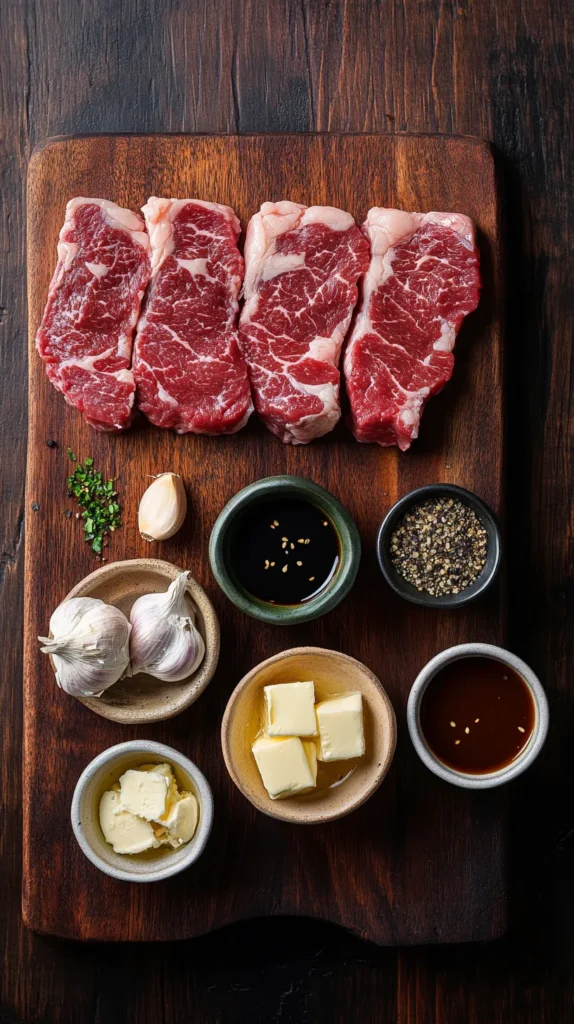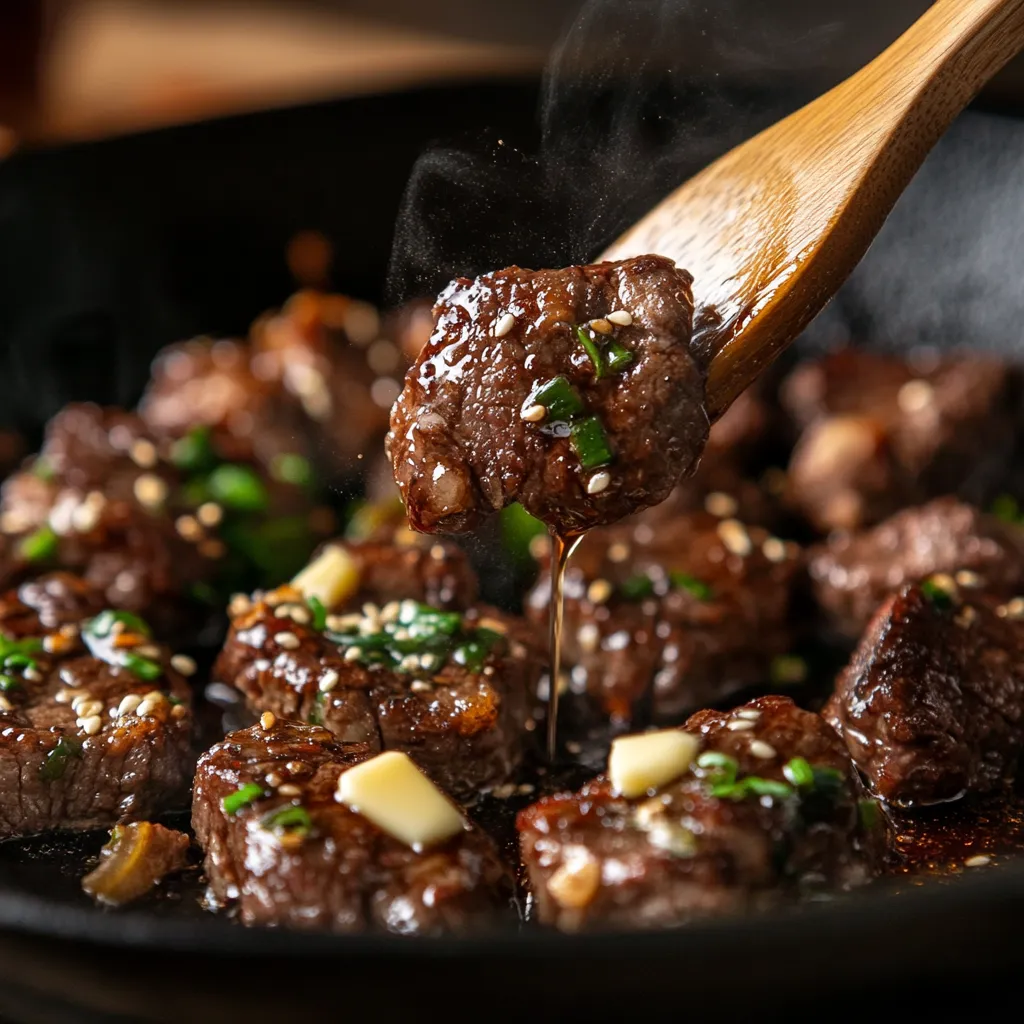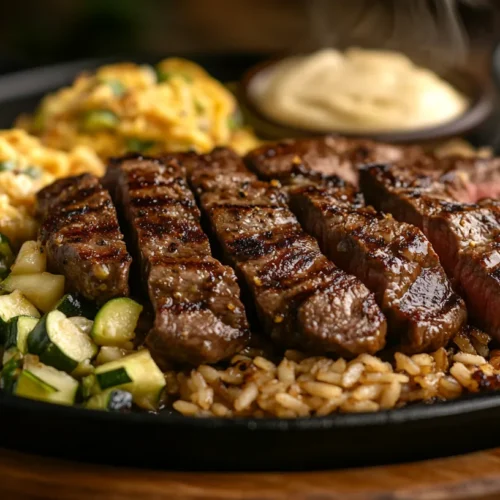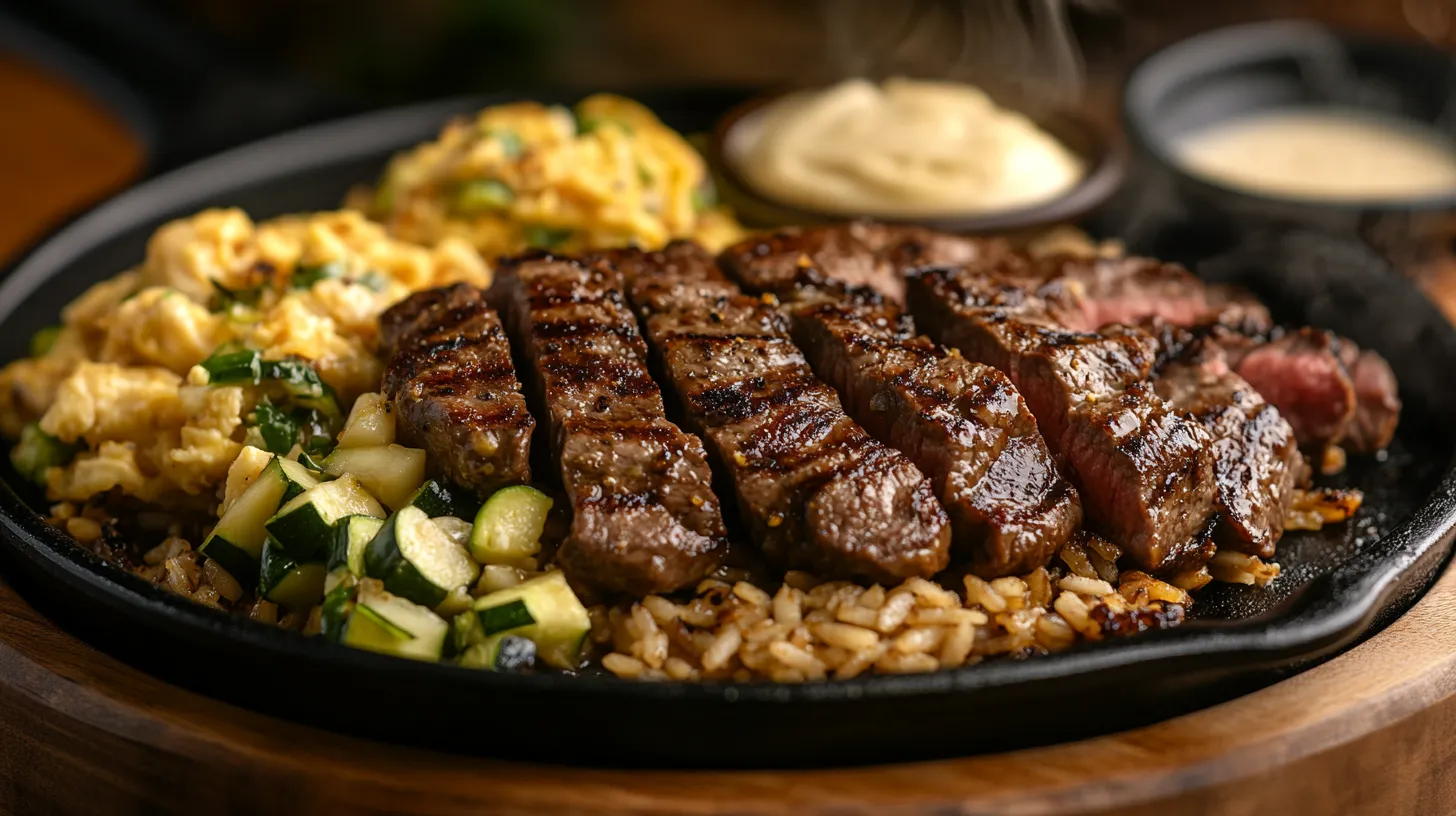Introduction
If you’ve ever sat at a Japanese steakhouse, mesmerized by the sizzling sounds and hypnotic knife skills of a hibachi chef, you know just how unforgettable hibachi steak can be. The perfectly seared, bite-sized pieces of tender steak, coated in a savory butter-soy glaze, deliver an explosion of flavor in every bite. Served alongside fried rice, hibachi vegetables, and creamy yum yum sauce, it’s no wonder hibachi-style steak has become a favorite worldwide.
The great news? You don’t need a professional teppanyaki grill or a hibachi chef to enjoy this dish at home. With the right ingredients and cooking techniques, you can recreate restaurant-quality hibachi steak using a cast iron skillet, griddle, or even a large pan on your stovetop.
In this recipe, we’ll walk you through exactly how to make tender, juicy hibachi steak at home, just like your favorite Japanese steakhouse. We’ll also share pro tips, variations, and serving suggestions so you can customize this dish to your taste. Whether you’re a hibachi pro or trying it for the first time, this guide will help you master the art of cooking steak hibachi-style—no chef tricks required!
Table of Contents
Key Benefits of Hibachi Steak Recipe
Why should you make hibachi steak at home instead of heading to a Japanese steakhouse? Simple—it’s delicious, easy, and customizable. Here are the top reasons why this recipe is worth trying:
1. Restaurant-Quality Steak at Home
Hibachi steak is known for its incredibly tender texture and deep, umami-rich flavor. The combination of high-heat searing, soy-based steak marinade, and garlic butter creates the perfect bite. With this recipe, you can achieve that steakhouse-style sear and flavor in your own kitchen—no expensive dinner reservations required.
2. Quick and Easy to Make
Unlike traditional steak recipes that require marinating for hours, hibachi steak cooks in under 15 minutes. The secret lies in bite-sized steak pieces that cook rapidly over high heat, allowing you to have a full hibachi-style meal on the table in no time.
3. Customizable for Any Preference
One of the best things about making hibachi steak at home is full control over ingredients. You can:
- Choose your favorite steak cut (ribeye, sirloin, or strip steak).
- Adjust the level of seasoning and sauces to suit your taste.
- Swap in other proteins like hibachi chicken or shrimp for variety.
- Make it low-carb by serving with hibachi vegetables instead of rice.
4. Budget-Friendly Alternative
Eating at a Japanese steakhouse can be pricey, especially if you add on fried rice, vegetables, and dipping sauces. By making hibachi steak at home, you can enjoy the same bold flavors at a fraction of the cost—plus, you’ll have leftovers for the next day!
5. Perfect for Meal Prep
If you love meal prepping, hibachi steak is an excellent option. You can cook a batch and store it in the fridge for quick lunches, grain bowls, or steak salads throughout the week. It reheats well and pairs with a variety of side dishes.
6. Cook It Your Way
Want a smoky char? Use a Blackstone griddle. Prefer a juicier bite? Cook it in a cast iron skillet with butter. Need a lighter version? Use less oil and add extra vegetables. The cooking method is flexible, so you can make it exactly how you like it.
Ingredients for Hibachi Steak Recipe
To achieve the signature Japanese steakhouse flavor, you’ll need a combination of high-quality steak, umami-rich seasonings, and a sizzling-hot cooking surface. Below are the essential ingredients to make hibachi steak at home, along with substitutions and variations to fit your preferences.

1. Steak Options (Choose One)
For the best results, use well-marbled, tender cuts that can handle high-heat searing without becoming tough. Here are the best options:
- Ribeye Steak – The most flavorful option, with rich marbling that melts into the meat.
- New York Strip Steak – A firmer texture but still juicy and full of flavor.
- Sirloin Steak – A leaner choice that’s still tender when cooked properly.
- Filet Mignon (Optional) – The most tender cut, but it’s pricier and less traditional for hibachi.
👉 Pro Tip: Cut the steak into bite-sized cubes (about 1-inch pieces) before cooking. This ensures even cooking and helps achieve the signature hibachi-style sear.
2. Hibachi Steak Marinade (For Extra Flavor – Optional)
While hibachi steak doesn’t require marinating, you can enhance the flavor by marinating for 30 minutes before cooking. Mix:
- ¼ cup soy sauce (low-sodium recommended)
- 1 tablespoon sesame oil
- 1 teaspoon minced garlic
- 1 teaspoon grated ginger
- 1 tablespoon rice vinegar
- ½ teaspoon sugar or honey (to balance flavors)
👉 Shortcut Option: If you’re short on time, skip the marinade and season the steak with salt, pepper, and soy sauce just before cooking.
3. Hibachi Steak Seasoning
Hibachi-style steak gets its flavor from simple but bold seasonings:
- Salt & Black Pepper – Enhances the steak’s natural flavor.
- Soy Sauce – Adds umami and depth.
- Garlic Butter – A must for that rich, restaurant-style finish.
- Sesame Oil – Infuses a nutty, toasted aroma.
👉 Secret Ingredient: A dash of teriyaki sauce can add extra depth to your steak, giving it that savory-sweet balance.
4. Cooking Ingredients
- 1 tablespoon vegetable oil or avocado oil (for high-heat searing)
- 1 tablespoon butter (adds richness and enhances the sear)
- 1 teaspoon minced garlic (for extra aromatic flavor)
👉 Best Cooking Surfaces:
- Cast Iron Skillet – Creates a deep sear and even heat distribution.
- Blackstone Griddle – Perfect for large batches and that authentic hibachi experience.
- Regular Skillet – Works if you don’t have a cast iron pan.
5. Hibachi Dipping Sauces (Optional but Recommended)
- Yum Yum Sauce – A creamy, slightly sweet dipping sauce made with mayo, ketchup, sugar, and spices.
- Ginger Sauce – A tangy, soy-based sauce with grated ginger and rice vinegar.
- Teriyaki Sauce – A sweet-savory glaze that enhances the steak’s flavor.
6. Optional Add-Ons (For a Full Hibachi Experience)
- Hibachi Fried Rice – Classic Japanese steakhouse-style rice made with soy sauce, butter, and eggs.
- Hibachi Vegetables – Sautéed zucchini, mushrooms, and onions for a balanced meal.
- Steamed White Rice – A simple side that pairs perfectly with hibachi steak.
How to Make Hibachi Steak Recipe
Cooking hibachi steak at home is easier than you might think. The key is high heat, fast cooking, and bold flavors. Whether you’re using a cast iron skillet, Blackstone griddle, or regular pan, this method will help you achieve tender, juicy steak with a perfect sear—just like at your favorite Japanese steakhouse.

Follow this step-by-step guide for the ultimate hibachi experience.
Step 1: Prep the Steak
- Choose Your Steak – Use ribeye, New York strip, or sirloin for the best results.
- Pat Dry the Steak – Use a paper towel to remove excess moisture. This helps the steak sear properly instead of steaming.
- Cut Into Bite-Sized Pieces – Slice the steak into 1-inch cubes for even cooking.
- Season the Steak – Sprinkle with salt, black pepper, and a dash of soy sauce for a simple but bold flavor.
👉 Pro Tip: If using a marinade, let the steak sit for 30 minutes before cooking for extra flavor.
Step 2: Heat the Cooking Surface
The secret to a perfect hibachi sear is high heat.
- Preheat a cast iron skillet or griddle over medium-high to high heat for about 3-5 minutes. The pan should be hot enough to sizzle immediately when you add the steak.
- Add Oil – Pour 1 tablespoon of avocado oil or vegetable oil into the pan and let it heat up.
👉 Best Cooking Tools:
✔ Blackstone Griddle – Ideal for large batches and restaurant-style hibachi.
✔ Cast Iron Skillet – Retains heat well and delivers a deep, flavorful crust.
✔ Regular Skillet – Works for home cooking but won’t give the same intense sear.
Step 3: Sear the Steak
- Add Steak Cubes to the Hot Pan – Spread them out in a single layer to ensure they sear evenly.
- Let the Steak Cook Undisturbed for 1-2 Minutes – This allows a deep, golden-brown crust to form.
- Flip the Steak Pieces – Use tongs to turn them over and cook for another 1-2 minutes.
- Add Minced Garlic & Butter – Toss in 1 teaspoon minced garlic and 1 tablespoon butter for a rich, flavorful finish.
- Drizzle with Soy Sauce – Pour 1-2 tablespoons of soy sauce over the steak for extra depth of flavor.
👉 Cooking Time Guide:
- Rare: 2 minutes total
- Medium-Rare: 3-4 minutes total
- Medium: 5 minutes total
- Well-Done: 6-7 minutes total
Pro Tip: If using a teriyaki or hibachi sauce, add it in the last 30 seconds of cooking to glaze the steak without burning.
Step 4: Rest and Serve
- Remove the Steak from Heat – Transfer to a plate and let it rest for 2-3 minutes. This helps the juices redistribute, keeping the steak tender.
- Garnish (Optional) – Sprinkle with sesame seeds, chopped green onions, or extra garlic butter for a restaurant-style touch.
Step 5: Make It a Full Hibachi Meal (Optional)
For a complete hibachi dinner, pair your steak with:
✅ Hibachi Fried Rice – Classic buttery fried rice with eggs and soy sauce.
✅ Hibachi Vegetables – Sautéed zucchini, mushrooms, and onions.
✅ Dipping Sauces – Serve with yum yum sauce, ginger sauce, or teriyaki sauce.
Pro Tips and Variations
Mastering hibachi steak at home comes down to a few key techniques. Whether you want to enhance the flavor, switch up the protein, or adjust the cooking method, these expert tips and variations will help you customize your hibachi steak recipe like a pro.
Pro Tips for Perfect Hibachi Steak
1. Use High Heat for the Best Sear
Hibachi steak gets its signature crust and smoky flavor from a hot cooking surface. Whether you use a Blackstone griddle, cast iron skillet, or stainless steel pan, make sure it’s piping hot before adding the steak.
✔ Test It: Sprinkle a few water droplets on the surface—if they sizzle and evaporate immediately, it’s ready.
2. Don’t Overcrowd the Pan
To achieve a perfect golden-brown crust, steak cubes need space to sear. Overcrowding the pan will cause the steak to steam instead of sear. Cook in batches if necessary.
✔ Pro Tip: Arrange the steak in a single layer and don’t move it for the first 1-2 minutes—this creates the perfect crust.
3. Let the Steak Rest After Cooking
Just like with a whole steak, resting bite-sized hibachi steak for 2-3 minutes allows the juices to redistribute, keeping the meat tender and juicy.
✔ Pro Tip: Cover the cooked steak loosely with foil while resting to retain warmth.
4. Enhance the Flavor with Garlic Butter
A classic Japanese steakhouse trick is finishing the steak with garlic butter. The buttery richness balances the umami from soy sauce, making each bite irresistible.
✔ How to Make It:
Mix 2 tablespoons butter with 1 teaspoon minced garlic and melt it over the hot steak just before serving.
5. Add a Light Sauce at the End
Hibachi-style steak doesn’t need a heavy sauce, but a light glaze adds depth of flavor. Try drizzling a bit of:
- Soy sauce – For classic umami richness.
- Teriyaki sauce – For a hint of sweetness.
- Sesame oil – For a nutty aroma.
✔ Pro Tip: Add sauce in the last 30 seconds of cooking so it coats the steak without burning.
Variations to Try
1. Different Steak Cuts
While ribeye, New York strip, and sirloin are the most common choices, you can try:
✔ Filet Mignon – Ultra-tender, mild flavor.
✔ Flank Steak – Leaner but great when marinated.
✔ Skirt Steak – Bolder beefy flavor, perfect for slicing thin.
2. Try It with Chicken, Shrimp, or Tofu
Want to switch it up? Hibachi-style cooking works well with:
✔ Hibachi Chicken – Cook cubed chicken breast or thigh the same way as steak.
✔ Hibachi Shrimp – Use peeled, deveined shrimp and cook for only 2-3 minutes.
✔ Tofu – For a vegetarian version, use extra-firm tofu, pressed and cubed, then sear it until golden.
3. Add a Spicy Kick
Want some heat? Try adding:
✔ Red pepper flakes – Stir in a pinch while cooking.
✔ Sriracha or chili paste – Mix with soy sauce for a spicy glaze.
✔ Wasabi or Japanese mustard – Serve on the side for dipping.
4. Make It Low-Carb or Keto-Friendly
✔ Skip the rice – Serve with steamed vegetables instead.
✔ Use coconut aminos – A lower-carb soy sauce alternative.
✔ Try cauliflower rice – A great substitute for traditional hibachi fried rice.
Serving Suggestions for Hibachi Steak
Hibachi steak isn’t just about the perfectly seared beef—it’s about creating a full Japanese steakhouse experience at home. Whether you want a classic hibachi-style meal or a lighter, low-carb option, these serving ideas will help you put together the perfect plate.
1. Classic Hibachi Steakhouse Meal
For an authentic hibachi restaurant experience, pair your hibachi steak with:
✔ Hibachi Fried Rice – Japanese-style fried rice cooked with soy sauce, eggs, and butter.
✔ Hibachi Vegetables – Sautéed zucchini, onions, and mushrooms for a balanced meal.
✔ Yum Yum Sauce – A creamy, tangy sauce perfect for dipping steak bites.
✔ Ginger Sauce – A bright, zesty sauce that adds contrast to the rich steak.
How to Serve:
- Plate the steak alongside fried rice and vegetables for a complete meal.
- Serve the dipping sauces in small bowls on the side.
✔ Pro Tip: Garnish the plate with toasted sesame seeds and chopped green onions for a restaurant-style presentation.
2. Low-Carb & Keto-Friendly Option
If you’re looking for a lighter way to enjoy hibachi steak, try these pairings:
✔ Cauliflower Fried Rice – A low-carb alternative that still delivers the hibachi experience.
✔ Steamed or Roasted Vegetables – Serve with broccoli, bell peppers, or bok choy.
✔ Avocado & Cucumber Salad – A refreshing contrast to the rich steak.
✔ Shirataki Noodles – A low-carb noodle option that works well with hibachi flavors.
✔ Pro Tip: Swap soy sauce for coconut aminos to reduce sodium while keeping that umami flavor.
3. Japanese-Inspired Steak Bowls
For a quick and modern twist on hibachi steak, try serving it in a steak bowl:
✔ Rice Base: Use sushi rice, jasmine rice, or brown rice.
✔ Veggies: Add edamame, shredded carrots, and avocado.
✔ Toppings: Drizzle with teriyaki sauce, sprinkle sesame seeds, and top with nori strips.
✔ Sauce: Add a spicy sriracha mayo or wasabi aioli.
How to Serve:
- Layer steamed rice, vegetables, and steak in a bowl.
- Drizzle with sauce and sprinkle toppings for a visually appealing meal.
✔ Pro Tip: Serve in a deep bowl with chopsticks to mimic Japanese donburi-style steak bowls.
4. Hibachi Steak Tacos (Fusion Twist!)
Turn hibachi steak into a fun, flavorful taco night option:
✔ Warm Flour or Corn Tortillas
✔ Steak Bites with Garlic Butter
✔ Shredded Cabbage or Lettuce
✔ Drizzle with Yum Yum Sauce
✔ Top with Pickled Ginger or Jalapeños
✔ Pro Tip: Use Japanese-style mayo instead of sour cream for a unique flavor.
5. Bento-Style Lunch Box
Pack leftover hibachi steak into a bento box for an easy lunch:
✔ Steak & Fried Rice in One Compartment
✔ Sliced Cucumber & Carrots on the Side
✔ A Small Container of Yum Yum or Teriyaki Sauce
✔ Pro Tip: Add a boiled egg and fruit slices for a balanced meal.
Conclusion
Hibachi steak is more than just a meal—it’s an experience. With its tender, juicy texture, bold umami flavors, and signature high-heat sear, this dish brings the flavors of a Japanese steakhouse straight to your kitchen.
By following this recipe, you’ve learned how to:
✔ Choose the best steak cuts for hibachi-style cooking.
✔ Use high heat to create a restaurant-quality sear.
✔ Incorporate garlic butter and soy sauce for that rich, savory taste.
✔ Customize the dish with different proteins, sauces, and side dishes.
Whether you’re making a classic hibachi dinner with fried rice and vegetables or experimenting with steak bowls, tacos, or low-carb options, this recipe is versatile and easy to adapt.
Now that you’ve mastered hibachi steak at home, you can enjoy this delicious, restaurant-worthy meal anytime—without the hassle of dining out.

Hibachi Steak Recipe
Ingredients
Steak Options (Choose One)
- For the best results use well-marbled, tender cuts that can handle high-heat searing without becoming tough. Here are the best options:
- Ribeye Steak – The most flavorful option with rich marbling that melts into the meat.
- New York Strip Steak – A firmer texture but still juicy and full of flavor.
- Sirloin Steak – A leaner choice that’s still tender when cooked properly.
- Filet Mignon Optional – The most tender cut, but it’s pricier and less traditional for hibachi.
- 👉 Pro Tip: Cut the steak into bite-sized cubes about 1-inch pieces before cooking. This ensures even cooking and helps achieve the signature hibachi-style sear.
Hibachi Steak Marinade (For Extra Flavor – Optional)
- While hibachi steak doesn’t require marinating you can enhance the flavor by marinating for 30 minutes before cooking. Mix:
- ¼ cup soy sauce low-sodium recommended
- 1 tablespoon sesame oil
- 1 teaspoon minced garlic
- 1 teaspoon grated ginger
- 1 tablespoon rice vinegar
- ½ teaspoon sugar or honey to balance flavors
- 👉 Shortcut Option: If you’re short on time skip the marinade and season the steak with salt, pepper, and soy sauce just before cooking.
Hibachi Steak Seasoning
- Hibachi-style steak gets its flavor from simple but bold seasonings:
- Salt & Black Pepper – Enhances the steak’s natural flavor.
- Soy Sauce – Adds umami and depth.
- Garlic Butter – A must for that rich restaurant-style finish.
- Sesame Oil – Infuses a nutty toasted aroma.
- 👉 Secret Ingredient: A dash of teriyaki sauce can add extra depth to your steak giving it that savory-sweet balance.
Cooking Ingredients
- 1 tablespoon vegetable oil or avocado oil for high-heat searing
- 1 tablespoon butter adds richness and enhances the sear
- 1 teaspoon minced garlic for extra aromatic flavor
👉 Best Cooking Surfaces:
- Cast Iron Skillet – Creates a deep sear and even heat distribution.
- Blackstone Griddle – Perfect for large batches and that authentic hibachi experience.
- Regular Skillet – Works if you don’t have a cast iron pan.
Hibachi Dipping Sauces (Optional but Recommended)
- Yum Yum Sauce – A creamy slightly sweet dipping sauce made with mayo, ketchup, sugar, and spices.
- Ginger Sauce – A tangy soy-based sauce with grated ginger and rice vinegar.
- Teriyaki Sauce – A sweet-savory glaze that enhances the steak’s flavor.
Optional Add-Ons (For a Full Hibachi Experience)
- Hibachi Fried Rice – Classic Japanese steakhouse-style rice made with soy sauce butter, and eggs.
- Hibachi Vegetables – Sautéed zucchini mushrooms, and onions for a balanced meal.
- Steamed White Rice – A simple side that pairs perfectly with hibachi steak.
Instructions
Step 1: Prep the Steak
- Choose Your Steak – Use ribeye, New York strip, or sirloin for the best results.
- Pat Dry the Steak – Use a paper towel to remove excess moisture. This helps the steak sear properly instead of steaming.
- Cut Into Bite-Sized Pieces – Slice the steak into 1-inch cubes for even cooking.
- Season the Steak – Sprinkle with salt, black pepper, and a dash of soy sauce for a simple but bold flavor.
- 👉 Pro Tip: If using a marinade, let the steak sit for 30 minutes before cooking for extra flavor.
Step 2: Heat the Cooking Surface
- The secret to a perfect hibachi sear is high heat.
- Preheat a cast iron skillet or griddle over medium-high to high heat for about 3-5 minutes. The pan should be hot enough to sizzle immediately when you add the steak.
- Add Oil – Pour 1 tablespoon of avocado oil or vegetable oil into the pan and let it heat up.
- 👉 Best Cooking Tools:
- ✔ Blackstone Griddle – Ideal for large batches and restaurant-style hibachi.
- ✔ Cast Iron Skillet – Retains heat well and delivers a deep, flavorful crust.
- ✔ Regular Skillet – Works for home cooking but won’t give the same intense sear.
Step 3: Sear the Steak
- Add Steak Cubes to the Hot Pan – Spread them out in a single layer to ensure they sear evenly.
- Let the Steak Cook Undisturbed for 1-2 Minutes – This allows a deep, golden-brown crust to form.
- Flip the Steak Pieces – Use tongs to turn them over and cook for another 1-2 minutes.
- Add Minced Garlic & Butter – Toss in 1 teaspoon minced garlic and 1 tablespoon butter for a rich, flavorful finish.
- Drizzle with Soy Sauce – Pour 1-2 tablespoons of soy sauce over the steak for extra depth of flavor.
- 👉 Cooking Time Guide:
- Rare: 2 minutes total
- Medium-Rare: 3-4 minutes total
- Medium: 5 minutes total
- Well-Done: 6-7 minutes total
- Pro Tip: If using a teriyaki or hibachi sauce, add it in the last 30 seconds of cooking to glaze the steak without burning.
Step 4: Rest and Serve
- Remove the Steak from Heat – Transfer to a plate and let it rest for 2-3 minutes. This helps the juices redistribute, keeping the steak tender.
- Garnish (Optional) – Sprinkle with sesame seeds, chopped green onions, or extra garlic butter for a restaurant-style touch.
Step 5: Make It a Full Hibachi Meal (Optional)
- For a complete hibachi dinner, pair your steak with:
- ✅ Hibachi Fried Rice – Classic buttery fried rice with eggs and soy sauce.
- ✅ Hibachi Vegetables – Sautéed zucchini, mushrooms, and onions.
- ✅ Dipping Sauces – Serve with yum yum sauce, ginger sauce, or teriyaki sauce.
Notes
Nutrition Information (Per Serving):
- Calories: 420 kcal
- Protein: 38g
- Total Fat: 26g
- Saturated Fat: 10g
- Carbohydrates: 3g
- Fiber: 0g
- Sugar: 1g
- Sodium: 760mg
- Cholesterol: 110mg
FAQs
What kind of steak do they use at hibachi?
Most hibachi restaurants use well-marbled, tender cuts of steak that can handle high-heat cooking. The most common choices include:
✔ Ribeye Steak – Known for its rich marbling and deep flavor.
✔ New York Strip Steak – A slightly firmer texture but still juicy and flavorful.
✔ Sirloin Steak – Leaner than ribeye but still tender and full of taste when cooked properly.
✔ Filet Mignon (Less Common) – Extremely tender but not as rich in flavor as ribeye or strip steak.
Each cut provides a different texture and flavor profile, but ribeye is the most commonly used due to its juicy, melt-in-your-mouth quality.
What style of cooking is hibachi?
Hibachi refers to a Japanese grilling style where food is cooked over high heat on a flat-top griddle or open-flame grill. The word “hibachi” translates to “fire bowl”, originally referring to a charcoal-heated cooking vessel.
However, in modern Japanese steakhouses, hibachi-style cooking is often confused with teppanyaki, where chefs use a flat iron griddle to cook steak, chicken, seafood, and vegetables in front of guests.
Key features of hibachi-style cooking:
✔ High-heat searing for a deep, smoky flavor.
✔ Butter, garlic, and soy sauce for a rich umami taste.
✔ Quick-cooking techniques to lock in juiciness.
While true hibachi cooking involves grilling over an open flame, most people use a Blackstone griddle or cast iron skillet at home to recreate the experience.
Why does hibachi steak taste so good?
Hibachi steak gets its signature flavor from a combination of:
✔ High Heat Cooking – Creates a crispy sear on the outside while keeping the inside juicy.
✔ Garlic Butter – Adds richness and depth to the steak’s flavor.
✔ Soy Sauce & Sesame Oil – Infuse umami and nuttiness.
✔ Minimal Seasoning – Enhances the steak’s natural taste without overpowering it.
✔ Fresh Ingredients – Hibachi-style cooking focuses on high-quality proteins and simple, bold flavors.
Additionally, the sizzling hot cooking surface allows the flavors to develop quickly, leading to that iconic steakhouse taste.
Where does hibachi steak come from?
Hibachi steak is inspired by Japanese grilling traditions, but the modern hibachi dining experience found in the U.S. is actually closer to teppanyaki cooking.
✔ The term “hibachi” originally referred to small charcoal grills used in Japan for cooking meats and vegetables.
✔ The Japanese steakhouse hibachi experience became popular in the U.S. in the 1960s, thanks to restaurants like Benihana, which introduced teppanyaki-style grilling with theatrical chef performances.
✔ While authentic hibachi grilling is still practiced in Japan, most hibachi steak recipes today are influenced by Westernized Japanese steakhouses that use flat-top grills instead of charcoal grills.
Now that we’ve covered everything from cooking techniques to steak selection, you’re ready to make the perfect hibachi steak at home!

